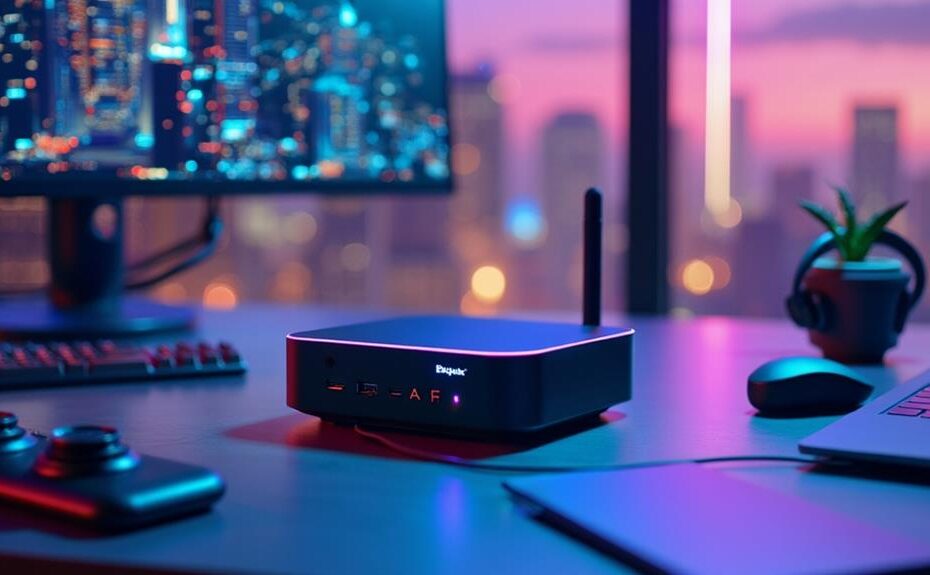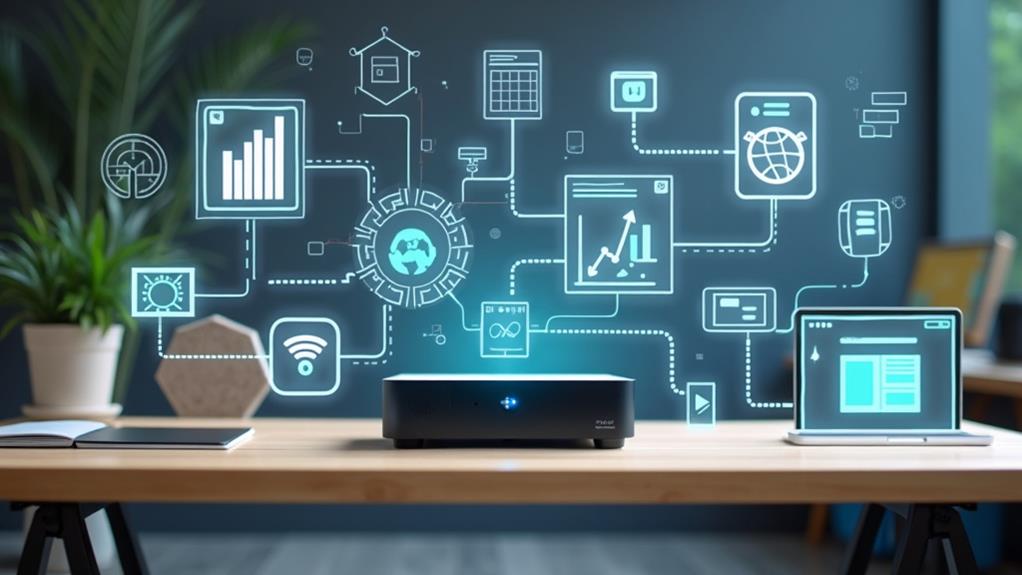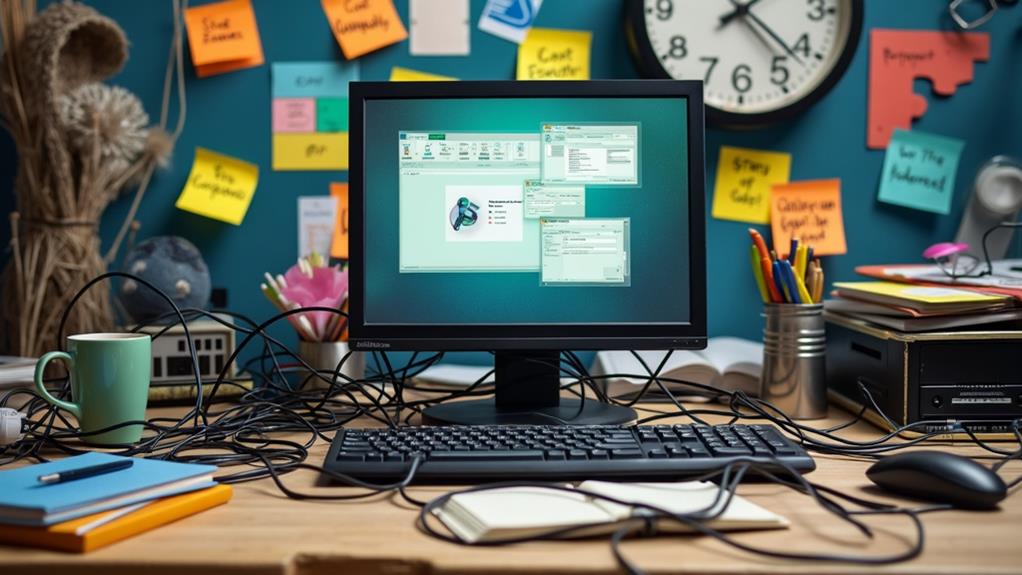



Mini PCs are redefining personal and enterprise tech solutions by offering high performance in a compact form. With advanced processors and support for significant RAM, they meet the demanding needs of remote work and multitasking seamlessly. Their energy-efficient designs lower electricity costs, making them eco-friendly choices for businesses and individuals alike. Plus, these versatile devices excel in specialized applications, from digital signage to home automation. As you explore the market, you'll find options that fit different needs and budgets, revealing how these innovative solutions can transform your tech landscape.
Key Takeaways
- Mini PCs are driving the trend towards remote work by offering compact, portable, and powerful computing solutions that enhance productivity in diverse environments.
- Advanced processors and energy-efficient designs enable mini PCs to deliver high performance while reducing electricity costs, making them ideal for personal and enterprise use.
- Their versatility allows mini PCs to excel in various applications, including digital signage, industrial automation, and server alternatives for small businesses.
- Customization options in RAM, storage, and graphics capabilities enable users to tailor mini PCs to specific needs, enhancing user satisfaction and productivity.
- Future-proofing technology ensures mini PCs remain relevant over time, with options that cater to both high-end applications and general usage requirements.
Mini PCs in Remote Work
In the domain of remote work, efficiency is paramount, and mini PCs are emerging as a game changer. These compact computing solutions seamlessly blend high-performance processors like Intel Core and AMD Ryzen with a small form factor, making them perfect for your limited home office space. You'll find that their energy-efficient design consumes around 15 watts, considerably less than standard desktops at 60 watts, helping you cut down on electricity costs while supporting eco-friendly practices.
Mini PCs are equipped with essential components, including customizable RAM and storage, allowing you to tackle demanding tasks with ease. Whether it's video conferencing or digital content creation, these devices maintain strong productivity levels without compromising performance. As remote work becomes increasingly prevalent, partly due to the COVID-19 pandemic, the global mini PC market is projected to grow at a rate of 5.04% from 2021 to 2026, highlighting the rising demand for these versatile machines.
Moreover, their portability enhances your flexibility in remote work environments, enabling you to set up in various locations effortlessly. Mini PCs truly redefine how you approach work from home, combining power, efficiency, and adaptability.
Technical Specifications Overview
When exploring mini PCs, understanding their technical specifications is essential to optimizing your computing experience. These compact devices are equipped with advanced processors, ranging from ARM chips to Intel's latest 10th and 11th generation Core processors, allowing you to tailor performance levels to your specific needs. For instance, the Intel 12th Gen i5-12450H processor, utilized in models like the Beelink SEi12, features 8 cores and 12 threads for supercharged performance, making it a standout choice for various applications. Supporting up to 64GB of DDR4 RAM, mini PCs enhance multitasking capabilities, making them ideal for demanding applications.
Solid-state drives (SSDs) are commonly integrated into these systems, offering faster boot and load times compared to traditional hard drives. This upgrade considerably improves overall system responsiveness. Additionally, the diverse connectivity options—including multiple USB ports, HDMI, and Ethernet—ensure compatibility with various external devices and networks, enhancing their versatility. The Beelink SEi12, for example, boasts versatile connectivity with USB 3.2, HDMI, DP, and Type-C ports, making it a great choice for improved productivity versatile connectivity options.
One of the standout features of mini PCs is their customizable specifications. You can choose the right balance of CPU power, RAM, and storage to meet your performance requirements and future-proof your system. This flexibility, paired with typically low energy consumption, makes mini PCs an efficient alternative for desktop computing, whether for personal use or enterprise solutions. Understanding these specifications will empower you to make informed decisions tailored to your specific computing needs.
Market Trends and Projections
The mini PC market is on an impressive upward trajectory, with projections indicating a substantial growth from $21.1 billion in 2022 to $33 billion by 2032. This shift is fueled by the growing trend toward remote work, where mini PCs come into play as efficient computing solutions that meet diverse business needs. Their compact computing design allows users to maximize limited space, making them ideal for home offices and versatile work environments. Additionally, mini PCs are designed to run software like Home Assistant effectively, allowing users to integrate various smart devices seamlessly into their setups. As a result, they are becoming an essential part of home automation systems that enhance everyday living.
Technological advancements in AI, IoT, and 5G are also driving the market for Mini PCs, enhancing their processing power and functionality. As businesses and consumers alike seek more adaptable technology, mini PCs are being increasingly adopted for applications such as digital signage and home entertainment.
With a projected compound annual growth rate (CAGR) of 4.5% from 2023 to 2032, the mini PC segment is proving its resilience and adaptability in a rapidly evolving technological landscape. By understanding these market trends, you can better appreciate how mini PCs are redefining personal and enterprise tech solutions, paving the way for a more compact and efficient future.
Selecting the Right Mini PC
With the mini PC market thriving due to its adaptability and growing demand, choosing the right mini PC has become increasingly significant for both personal and professional use. Start by considering the processor type; if you're tackling demanding tasks like video editing, opt for higher-performance CPUs like Intel Core i7 or AMD Ryzen. For example, the GMKtec Mini PC N100 features an Intel 12th Gen Alder Lake-N100 processor that provides a balance of performance and efficiency for various applications. For basic tasks, a lower-spec Celeron processor might suffice.
RAM plays an essential role in multitasking. A minimum of 16GB is recommended for resource-intensive applications. Don't forget about SSD storage—choose a model with adequate capacity between 128GB and 2TB to guarantee faster boot and load times.
Evaluate the form factor of the mini PC, especially if your workspace has limitations. Options range from ultra-slim designs to more robust models like Intel's NUC, which pack significant computing power into smaller devices.
Specialized Applications and Use Cases
Mini PCs' versatility has made them indispensable across various sectors, showcasing their ability to adapt to specialized applications with ease. In retail environments, these compact devices excel in digital signage, efficiently driving multiple displays without needing additional hardware. This capability enhances advertising efforts while saving valuable space.
In industrial automation, Mini PCs shine due to their small footprint and support for GPIO ports and legacy interfaces. They seamlessly integrate with existing equipment, increasing operational efficiency notably. For small businesses, Mini PCs serve as powerful alternatives to traditional servers, offering robust computing capabilities while occupying less space and consuming lower power—essential for cost-conscious enterprises.
The gaming sector has also embraced Mini PCs, particularly models that connect to external GPUs via Thunderbolt 3. This connection boosts graphics performance while maintaining portability, making it easier for gamers to enjoy high-quality experiences on the go. Additionally, in the domain of home automation, Mini PCs act as central hubs, controlling smart devices and streamlining user experiences in smart homes. These specialized applications highlight Mini PCs' adaptability, positioning them as key players in various tech solutions.
Comparative Analysis of Brands
When it comes to choosing a mini PC, understanding the differences between leading brands like Intel and Asus can considerably impact your decision. Intel NUCs are known for their high-performance capabilities, equipped with advanced CPU options like the Intel Core i7 and extensive RAM support. This makes them perfect for performance-oriented users and demanding applications. However, they typically come with a higher price tag due to their premium components.
On the other hand, Asus mini PCs provide a budget-friendly alternative, catering to both performance-oriented users and those looking for economical solutions. With diverse specifications available, Asus models focus on cost-effectiveness without sacrificing essential performance. Both brands allow for customization options, enabling you to tailor configurations to meet your specific computing requirements, including RAM, storage, and graphics capabilities.
Future-proofing is another critical factor to evaluate. Intel NUCs are often designed for high-end tasks and longevity, while Asus emphasizes a balance between affordability and performance, appealing to a broader audience. Ultimately, your choice will depend on your specific needs and total cost of ownership, ensuring you find the mini PC that best fits your lifestyle.
Disclosure: As an Amazon Associate, I earn from qualifying purchases.





